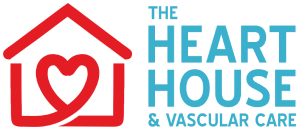Vascular Conditions & Treatments
The providers at The Heart House specialize in treating a variety of venous conditions and diseases using the most advanced procedures available.
What You Should Know:
Varicose veins, spider veins, venous ulcers, swollen veins, chronic venous insufficiency (CVI), and deep vein thrombosis (DVT) are common vascular conditions that we treat regularly.
While these conditions do not always pose an immediate health risk, they can cause discomfort, swelling, circulation issues, and undesirable aesthetic appearances. If you are experiencing discomfort from varicose veins or are unhappy with how they look on your body, there are a variety of treatment options available to eliminate or significantly reduce their visibility. Explore the different vein conditions that we treat:
Tortuous Veins
Tortuous veins are abnormally twisted or winding veins, typically in the legs. These often develop due to faulty valves in the veins that prevent proper blood flow back to the heart, causing blood to pool in the veins.
Cosmetic (Spider) Veins
Cosmetic spider veins are small, reddish-purple veins that typically appear on the legs and face. They have a web-like or tree-branch appearance and are often caused by sun exposure, aging, genetics, hormonal changes, valve deficiency, and pregnancy.
Chronic Venous Insufficiency (CVI)
Chronic venous insufficiency (CVI) is a condition where the veins in the legs have trouble sending blood back up to the heart, resulting in the pooling of blood in the veins. Weakened valves inside the leg veins can lead to swollen, enlarged veins, such as tortuous veins. While there is no cure for CVI, treatment can effectively manage symptoms and improve the quality of life for those affected.
Deep Vein Thrombosis (DVT)
Deep vein thrombosis (DVT) is a serious condition where blood clots form in the body's deep veins, usually in the legs. DVT can be caused by prolonged immobility, injury, surgery, pregnancy, and inherited blood clotting disorders.
Peripheral Arterial Disease
Peripheral arterial disease (PAD) is a condition in which the arteries that carry blood to the arms and legs become narrowed or blocked. This can reduce blood flow to the extremities, causing numbness, weakness, or pain.
Peripheral Vascular Disease
Peripheral vascular disease (PVD) is a term used for a range of disorders that affect the blood vessels outside the heart and brain. These conditions can significantly impact circulation, leading to pain, discomfort, and other potential complications.
Could PAD be Affecting Your Legs?
Take Our Free Online Assessment to Find Out
Our easy-to-use online self-assessment tool can help determine if you may be at risk for vascular conditions such as PAD or PVD. Take the assessment to see if you should schedule an appointment with one of our vascular specialists.
Advanced Diagnostic Testing Possibilities
Vascular Ultrasound
A vascular ultrasound is an imaging test that uses high-frequency sound waves to evaluate blood flow through the arteries and veins. This advanced diagnostic tool offers detailed information that can be used to diagnose and guide the treatment of numerous conditions affecting the veins and arteries.
Peripheral Computed Tomography Angiography (CTA)
Peripheral CTA is a non-invasive imaging technique used to evaluate vascular conditions beyond the heart. This advanced medical imaging technology utilizes X-rays and computer technology to create detailed images of the blood vessels in the peripheral areas of the body, including the arms, legs, abdomen, and pelvis.
Other common diagnostic tests offered include:
Ankle-Brachial Index (ABI) Screening
An ankle-brachial index (ABI) screening is a simple, noninvasive test used to check for peripheral artery disease (PAD) in the legs. It compares the blood pressure in the ankles to the blood pressure in the arms to determine how well blood is flowing.
Specialized Vein Procedures
Sclerotherapy
Sclerotherapy is a medical procedure used to eliminate varicose veins and spider veins. It involves injecting a special solution directly into the affected vein, which scars the vessel lining and causes it to swell shut. Over the next few weeks, the swollen vein will fade significantly due to the lack of blood supply, improving the appearance of the skin.Laser Vein Treatments
Laser vein treatments use heat from a laser to reduce the appearance of varicose veins. Laser treatment closes off the vein, cutting off the blood supply and redirecting it to surrounding healthy veins. The procedure takes less than an hour, and patients are typically able to go home the same day.
Phlebectomy
Phlebectomy is a minimally invasive procedure that uses a small needle or scalpel to precisely remove varicose veins that are close to the surface of the leg. During phlebectomy, the surgeon will make tiny punctures in the skin near the varicose vein and carefully remove the vein through the incision.
Radiofrequency
Radiofrequency vein ablation (RFA) is a technique used to treat varicose veins. During RFA treatment, your doctor will use radiofrequency energy to heat and close off the varicose vein. The vein will be absorbed in the tissue, and blood will be diverted to nearby healthy veins, diminishing the appearance of varicose veins.
Vein Stripping
Varicose vein stripping completely removes damaged veins from the legs and thighs. This minimally invasive procedure is done on an outpatient basis and helps prevent varicose veins from spreading or coming back after treatment. During the procedure, the surgeon will thread a thin, flexible plastic wire into the vein through a small incision in the groin and pull the vein out through another incision in the lower leg.
Photo Gallery
Video Gallery
Testimonials
Photo Gallery
Get To Know Our Cardiovascular Specialists
In Search of Care? Request a Consultation Today


 Fax: 856-547-5337
Fax: 856-547-5337
